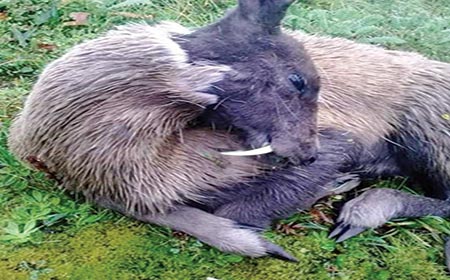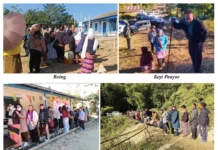[ Jonomo Rondo ]
Arunachal Pradesh is one of the richest forest-covered states of India, and the biggest among the northeastern states, with different species of flora and fauna. The state’s forests cover the eastern Himalayas up to the peak of Namcha Barua – one of the highest peaks in the region.
With its climatic conditions, cold to temperate and tropical forests, and different vegetations, there are several animal species, some of them rare, and some of them extinct due to mass killing and hunting. An example is the rarest-of-rare species of the musk deer, the males of which are killed for their testes for use by medical and perfume industries, especially in South East Asian countries like Singapore, Thailand, Cambodia, Philippines, Hong Kong, Indonesia and Malaysia, and also in East Asian countries.
Forest and man are both dependent on their ecosystem. In the earlier days, hunting was the main occupation in the tribal society, and was treated as a cultural heritage of the people. The people of the state still hunt for various reasons, but the musk deer are hunted only for commercial purposes, as they are highly valued in the international market. The testes are sold in exchange of money as well as goods, at the rate of between Rs 10,000 and Rs 15,000 per tola (10 grams), through agents or clients, to be smuggled out of the country.
Today, most of the countries have enacted laws to protect and preserve wildlife, particularly endangered species. If a society goes on counting customs and traditional practices, it becomes difficult to apply the modern laws. The society recognizes customary practices and enforces them. Modern law, be it civil law or criminal law, has a very limited scope to take on a society where customary practices are traditionally recognized as law enforceable among them.
It is customarily prescribed that each village community has its own hunting grounds and wildlife territory. The village community has the right to organise hunting trips or ‘phassi’ to kill wild animals.
However, such hunting is very rare in practice. Any form of customarily prescribed hunting is devoid of killing by poisoning, gunshot and other methods of trapping. In this way, there is a balanced system of hunting in the traditional society.
“In the Mishmi hills, it has been recognized that the population of the wildlife species is the highest compared to other districts of Arunachal. Some of the local stakeholders are doing a wonderful job for conservation of wildlife, allowing limited hunting, which is very encouraging,” said entrepreneur Jibi Pulu, who runs the Mishmi Hills Conservation and Protection of Endangered Wildlife, in collaboration with NGO Tiger Conservation, at the Dibang Wildlife Sanctuary in Lower Dibang Valley district.
The rarest species among the Mackek family, the hoolock gibbon, is available in the Mishmi hills as the locals do not hunt this animal, in keeping with sacred traditional beliefs.
Scholars like Sahil Nijwan and Ambika Ayadurai, both PhD researchers, have also studied the Idu Mishmi areas in depth, vis-à-vis wildlife and traditional hunting and rituals.
Nowadays, hunters use sophisticated methods and weapons in merciless, forceful and badly demonstrative ways, such as poisoning, gunshot, cage traps, and, in case of fishing, using bleaching powder and generators, in addition to explosives.
The high court’s ban over forest products has had a lopsided effect as it ignores one portion of the forest land, ie, wildlife. It is a fact that wildlife depends on the ratio of woods, the kind of vegetation and the environment required for the existence of plants and animals. In deserted/deforested areas, we hardly find good stock of wildlife. So, wildlife goes side by side with nature and the kind of forests we have.
A section of the people heaved a sigh of relief when the state government recently decided to ban massive killing of wild animals in the state, and instructed the district administrations and the environment & forest department to save the diminishing wildlife in the state.
Wildlife is a heritage of the ecosystem that requires to be honoured by humans. To address the matter of the quickly depleting wildlife, a beginning has to be made by local government officers and responsible members of the society to protect our wildlife from extinction.
To set a noble example, village folks, horticulturists, members of the public, and government officers should shun using guns to kill wildlife.
At the local level, daily markets in several districts openly sell poached animal meat. It reflects the nonexistence of forest personnel and other environmental workers in the districts.
It is high time that the society and the administrations started acting on various laws and acts to contain the high rate of killings. A thousand miles start with a single step, goes the saying. The GB and panchayati raj institutions should be asked to ensure preservation of forests and wildlife in the traditional village forests. (The contributor is District Research Officer, Lohit, and can be reached at jonomorondo@gmail.com)




